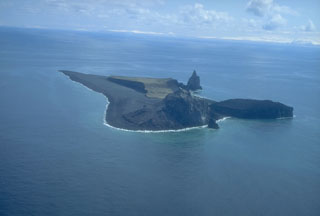Report on Bogoslof (United States) — 4 January-10 January 2017
Smithsonian Institution / US Geological Survey
Weekly Volcanic Activity Report, 4 January-10 January 2017
Managing Editor: Sally Sennert.
Please cite this report as:
Global Volcanism Program, 2017. Report on Bogoslof (United States) (Sennert, S, ed.). Weekly Volcanic Activity Report, 4 January-10 January 2017. Smithsonian Institution and US Geological Survey.
Bogoslof
United States
53.93°N, 168.03°W; summit elev. 150 m
All times are local (unless otherwise noted)
AVO reported that a five-minute-long seismic signal detected by sensors on islands near Bogoslof began at 2118 on 3 January along with a series of lightning strikes identified by the World Wide Lightning Location Network. An ash cloud identified in satellite data rose as high as 10 km (33,000 ft) a.s.l. and drifted N. AVO raised the Aviation Color Code (ACC) to Red and the Volcano Alert Level (VAL) to Warning. No other indications of activity were noted for the next few days, the ACC and the VAL were lowered to Orange and Watch, respectively, on 5 January. Later that day, at 1324, seismicity again escalated, and lightning strikes indicated another significant and short-lived (five minutes) explosion. The ash plume was visible on satellite images and observed by pilots, and had risen to an estimated altitude of 10.7 km (35,000 ft) a.s.l., detached, and drifted NNW. The ACC was raised to Red and the VAL was raised to Warning, but were again lowered one level the next day. Seismic and infrasound data from neighboring islands indicated another explosive event, beginning at 2230 on 8 January. Seismic data suggested two strong pulses, during 2233-2234 and at 2256, consistent with two distinct volcanic clouds observed in satellite images. The second cloud was larger, rising to an altitude of 10.7 km (35,000 ft) a.s.l. and drifting NW. The ACC was raised to Red and the VAL was raised to Warning, but were again lowered one level to Orange and Watch, respectively, the next day.
Geological Summary. Bogoslof is the emergent summit of a submarine volcano that lies 40 km N of the main Aleutian arc. It rises 1,500 m above the Bering Sea floor. Repeated construction and destruction of lava domes at different locations during historical time has greatly modified the appearance of this "Jack-in-the-Box" volcano and has introduced a confusing nomenclature applied during frequent visits by exploring expeditions. The present triangular-shaped, 0.75 x 2 km island consists of remnants of lava domes emplaced from 1796 to 1992. Castle Rock (Old Bogoslof) is a steep-sided pinnacle that is a remnant of a spine from the 1796 eruption. The small Fire Island (New Bogoslof), about 600 m NW of Bogoslof Island, is a remnant of a lava dome formed in 1883.
Source: US Geological Survey Alaska Volcano Observatory (AVO)

